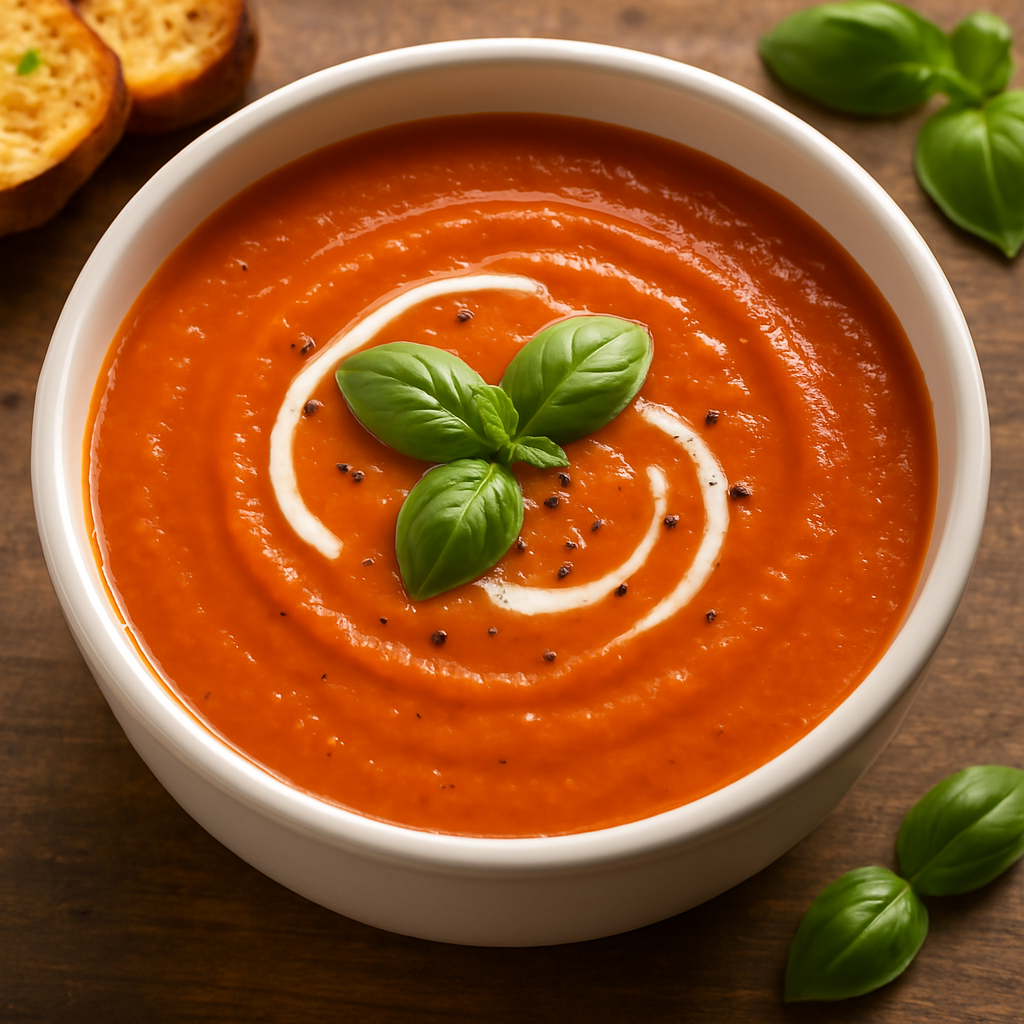Table of Contents
ToggleTomato Soup
Tomato soup
is one of the most comforting
food for winter season. In the evening
when the weather becomes cozy and you
need something to munch on this is one
the best thing to try…
History
Tomato soup has a long and fascinating history, evolving from a simple tomato-based broth into the popular dish enjoyed around the world today.
Origins and Early Development
- Pre-Colonial Times: Tomatoes originated in Central and South America, where they were cultivated by indigenous civilizations such as the Aztecs.
- 16th Century: Spanish explorers introduced tomatoes to Europe after their expeditions to the Americas. Initially, some Europeans viewed tomatoes with suspicion due to their association with the nightshade family.
- 18th Century: As tomatoes became a common ingredient in European cuisine, they were gradually incorporated into soups and stews, particularly in Italian and Spanish dishes.
Growing Popularity
- 19th Century: soup became more widely recognized, with recipes appearing in cookbooks across Europe and the United States. The dish was often made using fresh tomatoes, herbs, and simple seasonings.
- 1830s: French culinary traditions began including tomato-based soups, which influenced other cuisines.
- Late 19th Century: Advances in food preservation, including the canning , contributed to the soup’s increasing availability and convenience.
The Role of Campbell’s Soup
- 1897: Dr. John T. Dorrance, a chemist at Campbell Soup Company, created condensed tomato soup, making it more affordable and widely accessible. This innovation played a significant role in popularizing the dish across American households.
- 20th Century: Tomato soup became a staple comfort food, frequently paired with grilled cheese sandwiches in the United States.
Modern Adaptations
- Global Influence: Different cultures have put their own spin on soup, incorporating ingredients such as basil (Italian-style), cream (British-style), or spices (Indian-style).
- Contemporary Variations: With growing interest in health-conscious eating, modern versions of soup include organic, gluten-free, and dairy-free options, as well as gourmet recipes featuring roasted , fresh herbs, and specialty cheeses.
This simple and delicious homemade soup is rich, creamy, and packed with flavor.
Ingredients:
- 2 tbsp butter or olive oil
- 1 medium onion, chopped
- 2 cloves garlic, minced
- 4 cups (about 1 kg) ripe tomatoes, chopped (or 1 can of whole peeled )
- 2 cups vegetable broth or water
- 1 tsp salt (adjust to taste)
- ½ tsp black pepper
- ½ tsp sugar (optional, to balance acidity)
- ½ tsp dried basil (or 1 tbsp fresh basil)
- ½ cup heavy cream or milk (optional, for a creamy texture)
Instructions:
- Start by sauteing tomato
- In a large pot, we will melt butter or heat olive oil over medium heat.
- Then we will add the chopped onion and cook until soft and translucent (about 3-4 minutes).
- Now its time to stir in the minced garlic and we will cook for another 30 seconds until fragrant.
- Cook the Tomatoes:
- Add the chopped fresh or canned tomatoes along with salt, pepper, sugar, and basil.
- Stir well and let them cook for about 10 minutes until the tomatoes break down.
- Simmer:
- We will start Pouring in the vegetable broth and bring the mixture to a gentle simmer.
- Now lets Cover and cook for 15-20 minutes, stirring occasionally,if you don’t want to burn your soup.
- Blend the Soup:
- We can use an immersion blender to puree the soup until smooth.
- Start transferring the soup to a blender in batches and blend until creamy.
- Add Cream (Optional):
- If you prefer a creamier soup, stir in heavy cream or milk. Simmer for another 2-3 minutes.
- Serve:
- Taste and adjust seasoning if needed.
- Serve hot, garnished with fresh basil, croutons, or a drizzle of cream.
Tips & Variations:
- Roasted Soup: Roast the tomatoes in the oven at 400°F (200°C) for 20-25 minutes before adding them to the soup for a richer flavor.
- Spicy Kick: Add a pinch of red pepper flakes or cayenne for some heat.
- Thicker Soup: Stir in a tablespoon paste for a deeper tomato flavor
Benefits of eating Tomatoes
Rich in Nutrients these are a fantastic source of vitamin C, vitamin K, potassium, and folate, all crucial for maintaining good health. Their low-calorie count and high fiber content make them an excellent addition to any balanced diet.
2. Powerful Antioxidant Properties Packed with lycopene, tomatoes are powerful antioxidants that help shield our cells from damage due to free radicals. Cooking tomatoes, like in sauces or soups, enhances the effectiveness of lycopene.
3. Supports Heart Health The potassium and antioxidants can help lower blood pressure and reduce the risk of heart disease. Additionally, lycopene may help reduce levels of bad cholesterol (LDL) while boosting good cholesterol (HDL).
4. Good for Skin and Hair With high levels of vitamin C and lycopene, are beneficial for maintaining healthy skin, aiding in the reduction of aging signs and sun damage. Applying juice can also help lessen acne and tighten pores.
5. Supports Eye Health These are rich in beta-carotene, lutein, and zeaxanthin, which contribute to good vision and decrease the likelihood of age-related macular degeneration (AMD).
6. Aids Digestion The fiber supports healthy digestion and helps prevent constipation, while also assisting in the maintenance of a healthy gut microbiome.
7. Strengthens the Immune System Tomatoes are loaded with vitamin C, which enhances immunity and helps the body battle infections and colds.
8. May Reduce Cancer Risk The antioxidants, including lycopene , have been associated with a reduced risk of particular cancers, such as prostate, lung, and stomach cancer.
9. Helps in Weight Loss With their low calorie count and rich fiber content, can keep you feeling full longer, making them a smart choice for weight management.
10. Regulates Blood Sugar These have a low glycemic index (GI) which may help control blood sugar levels, making them suitable for those with diabete

